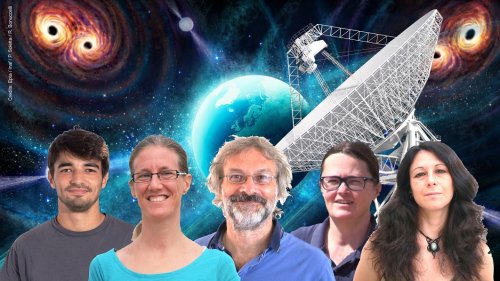
The English Royal Astronomical Society (RAS) is one of the most prestigious international scientific authorities and annually awards a series of prizes and medals for astrophysical and geophysical research. Among these is the Group Achievement Award, which was awarded to the LIGO collaboration in 2019 and the Event Horizon Telescope in 2021, and in 2025 was given to a large-scale scientific project in which the Italian contribution has been and continues to be very important since its inception: the European Pulsar Timing Array (EPTA).

EPTA was established in the early 2000s with the aim of detecting low-frequency gravitational waves through the joint observation of a series of highly precise “cosmic clocks,” the so-called “pulsars,” tiny but dense neutron stars whose beat (corresponding to a rotation on their axis) can vary, depending on the specific pulsar, from a few seconds to the extreme rate of 716 rotations in just one second: these pulsars are called “millisecond pulsars.” By correlating the tiny variations in the beats of these stars, it is possible to measure the passage of low-frequency gravitational waves coming from binary systems of supermassive black holes.
To understand how low the frequency of the gravitational waves investigated by EPTA is, and consequently how difficult they are to capture, we first recall that they, in accordance with Albert Einstein’s general theory of relativity, travel at the speed of light. Their frequency ranges from 1 to 100 billionths of a Hertz. Since one Hertz equals one cycle per second, the length of these waves ranges from about 0.3 light-years (which corresponds to about a thousand times the distance between the Sun and Neptune) to about 30 light-years, which is about 3 times the distance that separates us from the star Sirius.
To measure the minimal variations produced in space-time by these long waves, the EPTA consortium has brought together, over time, a dozen research institutes and over 80 researchers (as of 2025, but many more have been involved) who for 25 years have observed, and continue to do so, several dozen pulsars, about 60, selected for this purpose.
Since the early days of the third millennium (with some anticipations even in the 1990s), an observational phase began with the largest and most powerful European radio telescopes: Effelsberg (Germany), Jodrell Bank (United Kingdom), Nançay (France), and Westerbork (Netherlands), later joined by the Sardinia Radio Telescope of the National Institute for Astrophysics (Inaf), which at that time was still under construction in the hills around San Basilio, not far from Cagliari.
The then director of the Observatory and “father” of the SRT project, Nichi D’Amico, was among the first and most convinced supporters of this new and pioneering field of astronomical research (it is worth remembering that the official discovery of gravitational waves would only come in 2015, with the detection of high-frequency gravitational waves, around a hundred Hertz) and immediately worked on building a team of astrophysicists dedicated to EPTA, which still today relies on the experience of Andrea Possenti (former director of Inaf in Cagliari, now Research Director and member of the international EPTA board), Marta Burgay (discoverer of the famous and so far unique “double pulsar”), Delphine Perrodin (responsible in Sardinia for LEAP, a sub-project within EPTA), Caterina Tiburzi (one of the world’s leading experts on the effects that the interstellar medium imparts on millisecond pulsar signals), and the doctoral student Francesco Iraci. The EPTA group has also recently benefited from the collaboration of Maura Pilia and Alessandro Corongiu.
To this initial observational and technological phase, another has been added, characterized by more markedly theoretical studies in which the University of Milano Bicocca, with a team led by Alberto Sesana, and also the Gran Sasso Science Institute (GSSI), have successfully participated, demonstrating the variety and importance of the Italian role in EPTA.
The results of this over twenty-year work were initially presented in 2021 and subsequently in 2023, with a second important release that extended the previous data set, improved the determination of crucial parameters for the identification of low-frequency gravitational waves, and, not least, made the data available to other researchers.
Andrea Possenti explains: “The 2023 results were the outcome of a broad and decades-long effort where it was crucial to pool the best of the instrumentation (including INAF’s SRT) and European research, both in terms of pulsar studies and the astrophysics of ultra-long period gravitational waves. The combination of technical means and everyone’s capabilities was the key ingredient.”
This working method is precisely the basis for the reasons that led the Royal Astronomical Society to award a prize dedicated to the “results achieved by the group” (Group Achievement Award), as explained by the British institution itself, pending the official ceremony that will take place in a few months: “One of EPTA’s strengths is its broad, diverse, and egalitarian structure. By involving collaborators of different nationalities and backgrounds and particularly encouraging and supporting early-career researchers, EPTA is a model of international and generational collaboration.”
To learn more: